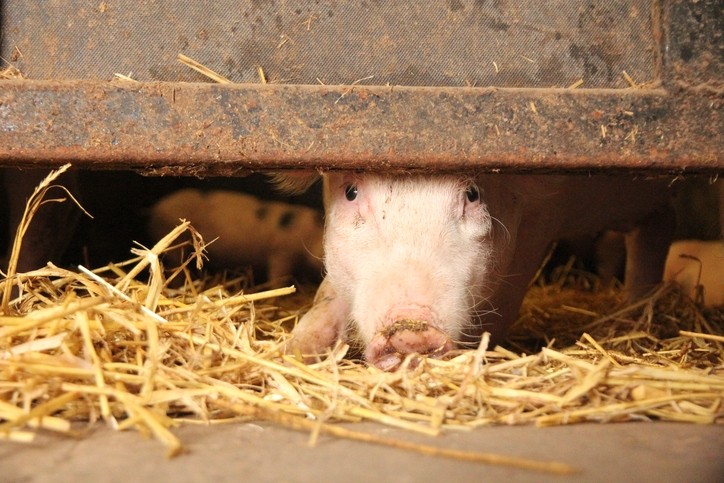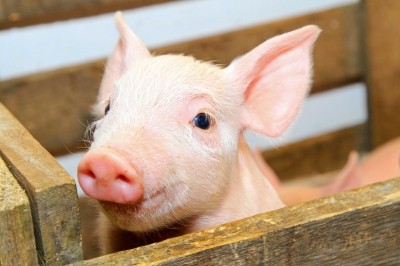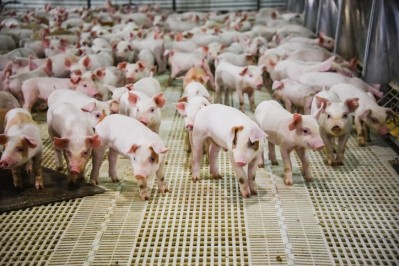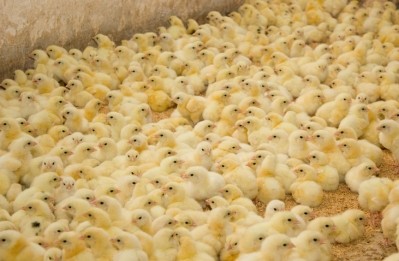Special Edition: Early animal nutrition
Tryptophan level, light exposure may alter piglet behavior but not feed intake

A team of researchers from Sao Paulo State University explored the addition of supplemental tryptophan (Trp) and light on piglet development during the post-weaning stage. Research team members published their work in the journal of Livestock Science.
“This study evaluated the effects of increasing dietary TL [tryptophan levels] (by 100%) on weaning pigs treated under different LP [light program] (12L:12D and 23L:1D),” the researchers said. “We tested if this increase was capable of reducing/neutralizing the negative effects of weaning over daily feed intake, daily weight gain, feed:gain ratio, blood glucose, plasma cortisol profile and behavior.”
The research team found that the light and feed supplement combination altered piglet plasma cortisol levels and some behaviors, while the light programs also changed feed efficiency, they said. However, the interaction between light and the feed supplement did not significantly change daily weight gain, feed intake or blood glucose.
“The association between altered cortisol profile and higher activity for piglets receiving 23 h of light/day indicates that these animals were more active than shorter light period,” they said. “However, this may be attenuated by the use of higher levels of dietary Trp.”
The additional light and increased feed additive did not improve piglet’s reactions to weaning stress, they added. “The results suggest that use of LP of 23 h light/day is not indicated for piglets.”
Why light and tryptophan levels?
Pigs tend to experience stress during the post-weaning period when litters are separated, which can lead to a change in behavior, the researchers said. The changes are often linked to a decline in feed intake, depression of the immune system, diarrhea and altered intestinal mucosa with “unbalanced microbiota.”
Changing the composition of a diet could help ease some negative effects from weaning stress, they said. When higher levels of tryptophan are added to the diet it can alter piglet susceptibility to stress and change behavior – it may help alleviate stress and improve welfare.
“Tryptophan is the fourth limiting amino acid for piglets fed soybean and corn-based meals,” the researchers said. “It is essential for protein synthesis, is the precursor of important metabolites, such as serotonin and melatonin that are involved in regulation of gastrointestinal function, expression and secretion of ghrelin, feed intake stimulation, temperature regulation and immune response.”
Artificial lighting also is used at different stages of pig farming because it can improve well-being, animal reproduction, behavior and improve piglet feed intake and growth performance, they said. “On the other hand, darkness periods are necessary for production and release of melatonin that acts on digestive system and works as an antioxidant, besides regulating the immune system, sleep-wake cycles and hormone concentration.”
As tryptophan is a precursor for serotonin, which is generated in the light phase and changed to melatonin in dark phases, there may be a relationship between the amount of dietary tryptophan and photoperiod that could address or improve piglet stress responses to weaning, they said.
Methods and materials
In the multi-factor study, 72 piglets weaned at 21 days of age were given one of two corn-soy-based diets and one of two light programs (LP) for a 24-day period, the researchers said.
In the diets, piglets received either 2.6g or 5.2g of Trp/kg feed in the pre-starter diet through day 14 of the trial and then either 2.4g or 4.8g Trp/kg feed on days 15-24, they said. Piglets on both diets also experienced either 12-hours or 23-hours of light a day.
Piglets were checked for growth performance, blood glucose levels, animal behavior and plasma cortisol profiles, they said. Piglets were weighed on day 0, 14 and 24 to establish eight gain and feed intake and the feed:gain ratio both were calculated.
Blood samples to establish glucose were taken on days 0 and 24, for cortisol on days 0 and 8 and behavior was noted on days 2, 9, 16 and 23, they said.
Results
Overall, there was no interaction found between the amount of light and tryptophan level on the amount that piglets age, daily weight gain or the feed:gain (F:G) ratio, the researchers said. Although, piglets on the high tryptophan diets tended to have better F:G ratios on day 24 and the piglets on the 12hour LP and high tryptophan diet tended to have the best daily weight gain.
There was an improvement in the F:G ratio for days 0-14, they said. The F:G ratio was improved by 7% in the piglets getting 12h of light and either level of supplemental tryptophan when compared to those getting 23h of light.
Additionally, there was an interaction regarding plasma cortisol levels at day 8 as piglets on the normal TL diet and getting 23h of light had more plasma cortisol than those getting 12h of light, they said. High dietary TL also increased the amount of plasma cortisol for piglets getting 12h of light, but not for those getting 23h of light.
An interaction between TL and LP was noted for piglet behavior regarding time spent feeding and time spent lying, they said.
“Piglets receiving 23 h of light/day and fed a normal TL-diet had higher frequency of ‘feeding’ behaviors and lower frequency of ‘lying’ behaviors, compared to piglets receiving 23 h of light/day and fed high TL-diets,” the researchers said. “They also had higher ‘feeding’ behaviors compared to piglets receiving 12-h of light/day and fed a normal TL diet – LP did not influence the frequencies of ‘feeding’ and ‘lying’ behaviors when piglets were fed a diet containing the highest level of tryptophan.”
Source: Livestock Science
Title: Impact of two light programs and two levels of dietary tryptophan for weanling piglets
Authors: Lívea Gomes, Gabriela Miassi, Luan dos Santos, Mayra Saleh, José Sartori, Marcos Tse, Dirlei Berto
DOI: doi.org/10.1016/j.livsci.2018.08.010












